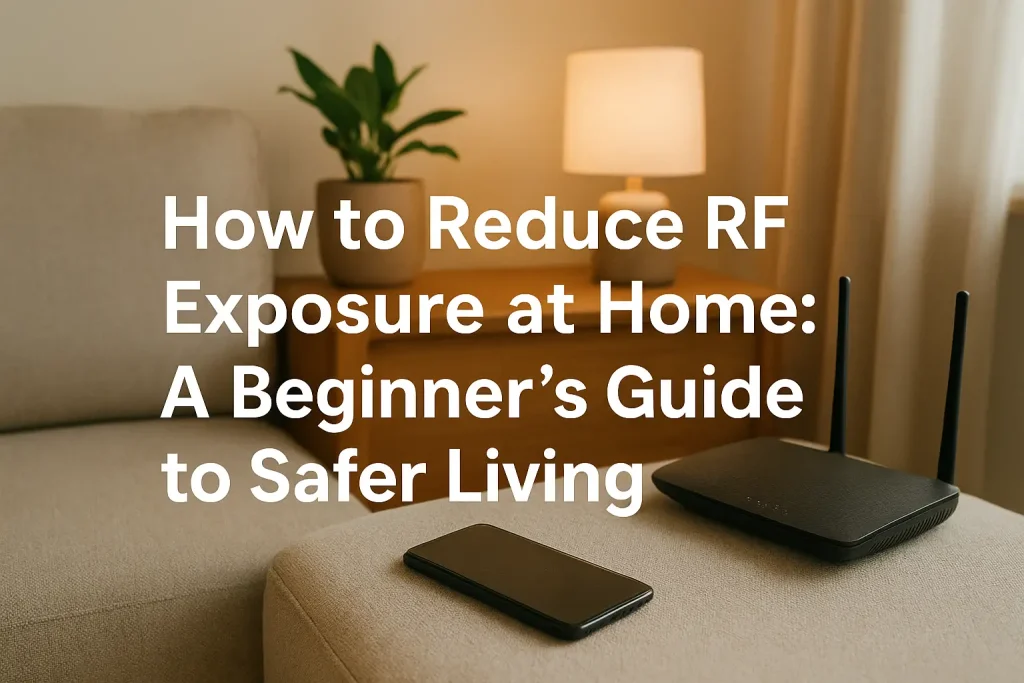In today’s hyper-connected world, our homes are filled with wireless technology. From Wi-Fi routers and smart TVs to Bluetooth devices and cell phones, we’re surrounded by invisible waves of energy known as radio frequency (RF) radiation. While research on long-term health effects is ongoing, many people are becoming cautious and looking for ways to create a healthier living environment.
This beginner-friendly guide will walk you through how to reduce RF exposure at home, explain why it matters, and provide simple, practical steps to minimize your exposures without giving up the conveniences of modern technology.
Understanding RF Exposure
Before diving into solutions, let’s break down what RF exposure actually means.
What is RF Radiation?
Radio frequency radiation is a type of non-ionizing electromagnetic field (EMF) emitted by wireless devices such as cell phones, Wi-Fi routers, cordless phones, baby monitors, and smart home devices. Unlike ionizing radiation (like X-rays), RF radiation does not break chemical bonds but can still interact with the body in subtle ways.
Why Should You Care?
Although government safety standards exist, some studies suggest potential links between prolonged RF exposure and health concerns like sleep disturbances, headaches, and fatigue. More research is needed, but if you’d like to take a proactive approach, reducing exposure is a safe and practical choice.
Common Sources of RF in Your Home
Awareness is the first step. Here are the most common sources of RF radiation you’ll likely find indoors:
- Wi-Fi Routers – Constantly transmitting signals, especially when left on 24/7.
- Cell Phones – Emit RF radiation during calls, streaming, and even when idle but connected.
- Cordless Phones – Base stations continuously send out strong RF signals.
- Smart Devices – Smart TVs, speakers, thermostats, and security systems all contribute.
- Baby Monitors – Many models use continuous wireless signals.
- Bluetooth Devices – Headphones, earbuds, and wearables add to your RF environment.
Once you know the culprits, you can make informed decisions to reduce your exposure.
Simple Lifestyle Changes to Reduce RF Exposure
1. Limit Wireless Use
The easiest way to reduce RF exposure is by cutting down on unnecessary wireless usage. For example:
- Turn off Wi-Fi when not in use, especially overnight.
- Use wired internet (Ethernet cables) whenever possible.
- Download content ahead of time instead of streaming constantly.
2. Keep Distance
RF exposure decreases significantly with distance. Try:
- Keeping your phone away from your body when not in use.
- Use speakerphone or wired headsets instead of holding the phone to your ear.
- Place Wi-Fi routers in less frequently occupied areas of your home.
3. Rethink Bedtime Habits
Your body restores itself during sleep, so minimizing RF exposure at night is particularly important.
- Avoid sleeping next to your phone; keep it in another room or at least several feet away.
- Turn off your Wi-Fi router overnight with a simple timer switch.
- Consider using a battery-powered alarm clock instead of your phone.
Device-Specific Tips
Reducing RF from Cell Phones
- Text instead of calling when possible.
- Keep calls short.
- Avoid carrying your phone directly against your body, like in a pocket or bra.
Lowering Wi-Fi Exposure
- Replace wireless internet with wired connections where practical.
- If wireless is necessary, upgrade to a router with a low-emission setting.
- Position the router away from bedrooms and main sitting areas.
Managing Smart Home Devices
- Turn off smart features you don’t need.
- Choose wired alternatives for speakers, lights, and security systems.
- Update device firmware regularly, since newer models often have improved safety features.
Creating an RF-Conscious Home Environment
Use Shielding Products (Cautiously)
There are shielding paints, fabrics, and cases designed to block RF radiation. While these can be helpful, they should not replace lifestyle changes. Overreliance on shielding can sometimes increase exposure by causing your devices to emit more power to maintain connections.
Embrace Wired Technology
Wired connections are not only safer from an RF perspective but also more reliable and secure. Switching to wired keyboards, mice, and speakers can gradually reduce your wireless footprint.
Educate Family Members
If you share a home, reducing RF exposure works best when everyone is on board. Teach kids to keep tablets on airplane mode when playing games offline, and encourage teens to avoid sleeping with phones under their pillows.
When to Consider Professional Help?
If you want a clearer picture of your home’s RF environment, consider consulting a professional who specializes in EMF assessments. They can use specialized equipment to measure exposure levels in different rooms and recommend tailored solutions. This is especially useful if you live near cell towers or in apartment buildings with multiple Wi-Fi networks.
Balancing Technology and Health
It’s important to remember that technology itself isn’t the enemy. Wireless connectivity brings incredible convenience, productivity, and entertainment to our lives. The goal is not to live in fear of RF radiation but to take smart, manageable steps to reduce unnecessary exposure.
By being intentional—turning off devices when not in use, keeping some distance, and using wired alternatives where practical—you can create a healthier, lower-exposure home without sacrificing modern comforts.
Conclusion
Learning how to reduce RF exposure at home doesn’t mean abandoning technology; it means using it wisely. Start small with changes like turning off Wi-Fi at night, keeping your phone away from your body, and swapping some wireless gadgets for wired options. Over time, these habits add up to a safer, more balanced living environment.
If you’re looking for a more precise understanding of your home’s exposure levels, radio frequency EMF testing can provide valuable insights and peace of mind. With awareness, practical action, and the right tools, you can take control of your indoor environment and support a healthier lifestyle for you and your family.
Frequently Asked Questions:-
1. What is RF exposure and why should I care?
- RF exposure refers to the radio frequency radiation emitted by wireless devices like Wi-Fi routers, cell phones, and smart home gadgets. While it’s non-ionizing and less harmful than X-rays, some studies suggest long-term exposure may contribute to issues like poor sleep, headaches, or fatigue. Taking simple precautions helps create a safer home environment.
2. Does turning off Wi-Fi at night really make a difference?
- Yes. Wi-Fi routers transmit continuously, even when you’re not actively using the internet. Turning them off at night gives your body several hours of reduced exposure while you sleep, which is when your body repairs and restores itself.
3. Are shielding products like EMF cases and fabrics effective?
- They can reduce exposure in certain situations, but they shouldn’t replace lifestyle changes. In some cases, shielding products may even cause devices to work harder and increase emissions. The best approach is to use shielding cautiously, combined with practical steps like distance and wired connections.
4. Is it safe for children to use tablets and phones?
- Children are more vulnerable because their bodies and brains are still developing. It’s best to limit wireless use, encourage airplane mode when possible, and keep devices away from their heads and bodies. Wired alternatives for internet use are always safer.
5. How can I know my home’s RF exposure levels?
- The most accurate way is through radio frequency EMF testing performed by professionals using specialized equipment. They can identify hotspots in your home and suggest tailored solutions to minimize exposure effectively.


